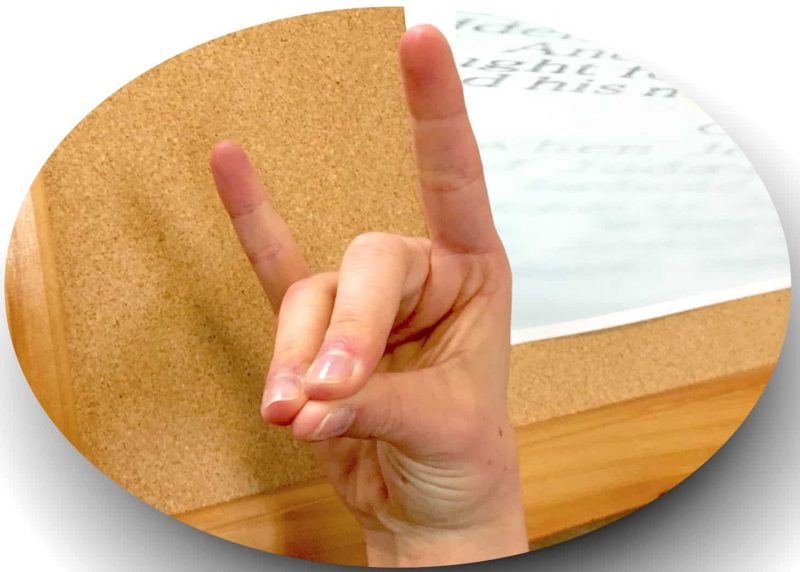Quiet coyote is a very popular hand signal that is used to encourage children to pay attention. It’s most common among those that are in charge of a large group of younger children, such as elementary school teachers.
To make the quiet coyote signal, you simply put your two middle fingers together. Then, you touch your thumb to your two middle fingers.
Raise your pinky and forefinger. The two middle fingers are the coyote’s mouth. Your two fingers that are sticking up represent the coyote’s ears.
In this article
What Does The Quiet Coyote Hand Signal Mean?
The quiet coyote hand signal means that the children should be quiet and pay attention, just as the animal is. Most parents or teachers use this signal when the kids are being too loud or they are not paying attention. It simply means to settle down and listen to what someone is saying.
My littlest gets distracted quite a bit. She can also be a bit defiant. I don’t like to use a “look” or yell at her. Instead, I simply stand still and use this signal. She knows that it is a reminder to help her pay attention.
The Origin Of The Quiet Coyote Hand Signal
No one is sure what the origin of the quiet coyote hand signal is. These animals are commonly found in North America, leading most people to believe that this sign originated in North America.
However, it is also used on other continents with other animals, such as the Silent Fox. Other names for the quiet coyote signal include, but are not limited to:
- Silent fox
- Focus fox
- Whisper wolf
- Silent serval
Although there are different names behind these, they all mean the same thing: children should lower the noise level and/or pay attention.
Psychology Behind The Quiet Coyote Signal
The reason that the quiet coyote signal is so popular is because of the psychology behind it. Using non-verbal cues has quite a few benefits. It also avoids some of the downfalls of using verbal commands for children.
Doesn’t Embarrass Children
When children are in a large group, calling a child out for being loud can be embarrassing. When a young child gets embarrassed, they are more likely to act out than to settle down.
This can also cause damage to their self-esteem if it happens repeatedly. The louder child in the group can quickly wind up feeling as though they are being picked on by the teacher. A hand signal is a gentle reminder that won’t make them feel embarrassed.
Non-Verbal Cues Are More Effective For Defiant Children
When children are traumatized or suffer from a mental illness like Oppositional Defiant Disorder they are more likely to be defiant. As children progress through developmental phases, they are also defiant. This is simply them asserting their independence.
Children that are defiant or are feeling defiant are less likely to listen to adults or other people in an authoritative position. That means that when you tell them to be quiet, they are instantly going to begin to argue.
Instead of being quiet, they may get louder. Every command you issue is perceived as a challenge.
That isn’t the case with non-verbal commands. Because you simply make a motion with your hand, children are more likely to listen. If they do argue, you remain quiet and hold your hand up. It stops the situation from escalating before it has the chance to.
You Don’t Have To Yell Over Loud Children
Yelling has been proven to have negative consequences. It does more to stifle children and intimidate them. You don’t want to scare children into listening. Instead, you want them to listen because they respect you.
That means that you need to use a gentle form of encouragement to get children to listen. Non-verbal cues like the quiet coyote hand signal do just that without causing damage to children.
Makes The Child Responsible
Instead of children having to listen to what they are told to do, hand signals encourage the child to control their actions because they see the signal. This helps children learn responsibility and holds them accountable for their actions.
Doesn’t Make The Child Feel Like They Are In Trouble
When we tell children to be quiet, we often signal that they are doing something wrong. As adults, we don’t mean to do this, but it’s the outcome. It can lead to children feeling ashamed or guilty.
Over time, children learn not to talk at all for fear that they will get in trouble. Non-verbal signals do not produce this same reaction in children.
It’s Easier For Adults
Children are by nature impulsive and occasionally loud, particularly when excited. This can lead to adults feeling the need to frequently tell children to be quiet or settle down. It can easily get frustrated for adults.
Non-verbal signals like the quiet coyote signal are easier to use. They can be held up for a long time to signal children that they still need to be quiet.
Should You Use The Quiet Coyote Hand Signal?
View in gallery
While there are quite a few people that use this signal, it’s not for everyone. In some countries, it’s illegal. Other people may feel that it’s pointless because you have to make sure that the children see the signal.
In this situation, it can be helpful to say quiet coyote in addition to putting up the hand signal. However, whether you choose to use this signal or not is up to you.
Why Are Some People Against This Signal?
There are quite a few people that are against this signal, but it’s not because they agree with yelling at children.
Instead, it’s because the signal itself is similar to other hand signals that symbolize things adults don’t want children associated with at all. Because of this, the signal is illegal in some countries, including France.
Quiet Coyote Is The Same As The Grey Wolves Salute
This salute is used by the Grey Wolves, a group of far-right extremists in Turkey. This militant group became well-known as an anti-communist group during the cold war.
In more recent years, however, they have made international headlines due to their violent altercations. In particular, they became known for their violence towards the Armenian community, particularly in France.
They are known for their participation in crimes that include but are not limited to, assassinations, robbery, desecration of memorials, torture, and more. You can read more about this group here.
It’s understandable why some people would not want to use this signal, teach it to their children, and why it is banned in some countries.
Other Things The Quiet Coyote Symbolizes
While the Grey Wolves are most well known for this symbol, that is not the only thing that this hand signal is associated with. Other things that this hand signal can symbolize include:
- Devil horns
- To symbolize the horned god in pagan rituals
- Infidelity in Latin countries
- It is the symbol for I love you in sign language
Most families that have strong Christian values might be opposed to their children using this symbol. It’s important to keep this in mind before using it with children as some parents might be opposed to this symbol.
Sending home a letter to keep parents informed and open the door for communication is recommended before introducing this symbol to the classroom.
Tips For Using Quiet Coyote

If you choose to use the quiet coyote to signal children to be quiet, it’s important that you make sure it’s effective. Simply standing in front of children and using this hand signal will not work. Instead, you’ll need to use these tips.
Start With A Lesson On Coyotes
If you’re going to use the words quiet coyote, start off with a lesson about coyotes. If you’re using a different animal, you want to have a lesson about that animal.
For example, for a silent fox, you would have a lesson about foxes. Make sure that you include cool facts to keep children engaged, and explain how the animal acts when they are quiet.
Explain The Hand Gesture
Next, you want to explain the hand gesture to children. Tell them that when you use that hand signal, it means that children should be quiet. They need to be quiet and pay attention just like the coyote, fox, etc.
Practice
After explaining the hand signal to the kids, it’s important to practice. Tell them to start talking. Then, hold up the hand signal to signal them to be quiet. Do this two or three times to practice with them.
Make Sure That You Can Be Seen
Before using this hand signal, make sure that you can be seen by the entire class. The kids will not be able to see you if you use the quiet coyote signal while sitting at your desk. Instead, stand up in front of the entire class.
Use A Verbal Command If You Have To
A hand signal is not always going to work. If the kids are sitting at their desks or all together in a group it will. However, there are going to be times, such as at recess, when most children will not see the signal. In this case, it’s helpful to also say quiet coyote as a signal to be quiet.
Quiet Coyote Alternatives
Because of the quiet coyote controversy, and the negative associations, it’s understandable that some people won’t want to use it. Parents may also be against teachers using it.
Thankfully, you can use alternatives that accomplish the same thing. Alternatives can include:
- Singing a song that involves hand gestures to engage the children
- Putting your hands on your head
- Clapping
Alternatives That Do Not Involve Using Hand Gestures
Hand gestures are great, but they don’t always work. Songs also aren’t always going to be effective. If the children are being especially loud or running around, they might not hear or see you. Instead, consider these alternatives to quiet coyote:
- Turning the lights off
- Flickering the lights on and off
- Holding up a stop sign
These gestures avoid hand symbols that parents might not like yet still encourage the children to be quiet and listen.
Utilize Positive Reinforcement
- Includes: Soft Behavior Chart & 4 Magnetic Dry-Erase Markers. Black, Blue, Green and Red!
- Stylish & Attractive: Your 17 x 13 inches Reward Chart will fit on any refrigerator, mini or full size. Your magnetic Chore Chart will flatten onto your fridge with minimal effort.
- No Extra pieces to lose or Fuss With. You or Your Child Can Just Fill In Stars with Your Favorite Color
Prices pulled from the Amazon Product Advertising API on:
Product prices and availability are accurate as of the date/time indicated and are subject to change. Any price and availability information displayed on [relevant Amazon Site(s), as applicable] at the time of purchase will apply to the purchase of this product.
Positive reinforcement is a powerful tool that parents and teachers can use frequently. When you see a child do something they are supposed to do, offer plenty of praise.
If children are struggling to listen to the quiet coyote signal, consider using a reward chart to encourage them to be quiet when you use the signal. Rewards and positive reinforcement are often more powerful than negative reinforcement and help promote healthy self-esteem.
In Conclusion
Although you have to keep in mind the quiet coyote controversy, this is still a popular method utilized in North America.
In European countries, most teachers and parents are using alternatives to quiet coyote hand signals. Regardless of the method that you use, these tips will help increase effectiveness.








